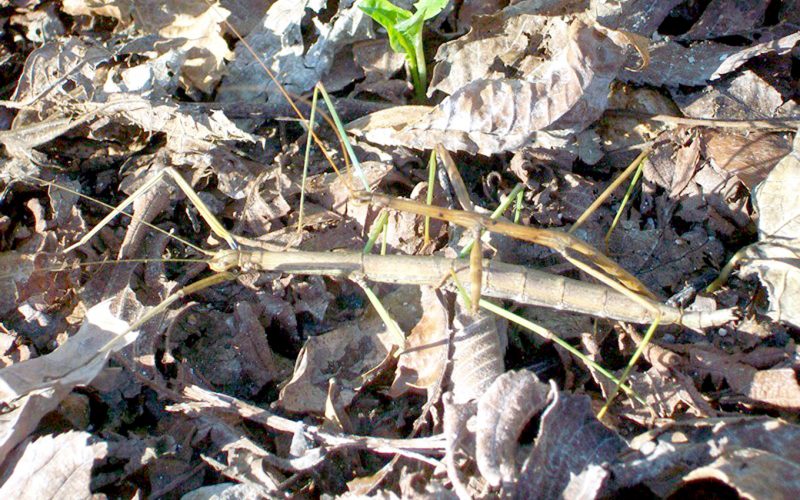
Staff Photo Amanda Bancroft
Giant Walking Sticks, pictured here as they mate near Fayetteville, are common in the leaf litter in Arkansas woods. Males are much smaller than females, and as far as we know do not compete for the right to mate.
Human relationships seem to be the most complicated in the world, with courtship possibly lasting years before a pair settles down. Our native species have their own ways of expressing themselves, and their mating rituals can appear quite surprising.
Bald Eagles seem to be masters of monogamy, and maybe it’s because of their mating rituals. Eagle courtship involves a “flight dance” of swoops, cartwheels, and a talon-locked free fall during which the pair separates just before hitting the ground like a crazy trust exercise!
Mating honey bees couldn’t be described as sweethearts. Drones have a detachable penis, called the endophalus, that remains inside the queen bee after their mating flight (sadly for the drone, he dies). Porcupine males interest a female by urinating all over her, and very, very carefully mating with her only if she’s interested (if she’s not, she screams and shakes off his urine). Fire ants have a fiery social structure: female workers kill off their male brothers while larvae, but the queen lays so many male eggs that some escape to mate with her.
Red Foxes tend to startle their neighbors during courtship. The vixen’s cry has been compared to a human female screaming in terror, and this sound has given rise to more than one local legend about haunted hollers and ghost stories. There’s no evidence that the vixen is screaming in pain, however; it’s merely the way of the fox.
Ruby-throated hummingbirds are dancers of the air, or rather, gymnasts. Audubon.org compares the male’s efforts to a pendulum swinging: “In courtship display, the male flies back and forth in front of the female in a wide U-shaped “pendulum” arc, making a whirring sound on each dive. Also he buzzes back and forth in short passes in front of a perched female.”
Eastern Screech Owls mate for life, and are getting ready to breed starting in March. They have an elaborate courtship ritual involving a lot of head-bobbing from the male. Great Horned Owls mate during winter when the nights are longest, giving them a hunting advantage over daytime predators. The males and females hoot at each other, and males usually display and fly up and down on a perch before hesitantly trying to rub beaks or bring prey to the female for sharing.
Even tiny lizards have courtship behavior. Five-lined skinks engage in head bobs, chin rubbing, and scratching before copulating for just ten minutes before going their separate ways. Fence lizards do pushups not only to attract females, but also to defend territory.
The mighty mountain lion would seemingly pose a threat to their mate. But a mating pair is not usually violent with each other. According to National Geographic, females become especially vocal and playful during estrus, batting at bushes and wiggling under their mates apparently just for fun. With rituals at times deadly or delightful, our local wildlife certainly know how to get it on.
Amanda Bancroft is a writer, artist, and naturalist building an off-grid cottage for land conservation on Mt. Kessler. She and her husband Ryan blog about their adventures and offer a solar-hosted online educational center on how to make a difference with everyday choices at: www.RipplesBlog.org.










